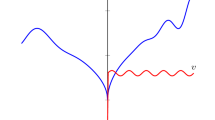Abstract
Viscous boundaries are widely used in numerical simulations of wave propagation problems in rock mechanics and rock engineering. By using such boundaries, reflected waves from artificial boundaries can be eliminated; therefore, an infinite domain can be modeled as a finite domain more effectively and with a much greater accuracy. Little progress has been made, thus far, with the implementation and verification of a viscous boundary in the numerical, discrete element, discontinuous deformation analysis (DDA) method. We present in this paper a new viscous boundary condition for DDA with a higher absorbing efficiency in comparison to previously published solutions. The theoretical derivation of the new viscous boundary condition for DDA is presented in detail, starting from first principles. The accuracy of the new boundary condition is verified using a series of numerical benchmark tests. We show that the new viscous boundary condition works well with both P waves as well as S waves.




















Similar content being viewed by others
References
Berenger J-P (1994) A perfectly matched layer for the absorption of electromagnetic waves. J Comput Phys 114(2):185–200
Doolin DM, Sitar N (2004) Time integration in discontinuous deformation analysis. J Eng Mech 130(3):249–258
Gu J, Zhao ZY (2009) Considerations of the discontinuous deformation analysis on wave propagation problems. Int J Numer Anal Methods Geomech 33(12):1449–1465. doi:10.1002/nag.772
Jiao YY, Zhang XL, Zhao J, Liu QS (2007) Viscous boundary of DDA for modeling stress wave propagation in jointed rock. Int J Rock Mech Min Sci 44(7):1070–1076
Liu GR, Quek Jerry SS (2003) A non-reflecting boundary for analyzing wave propagation using the finite element method. Finite Elem Anal Des 39(5–6):403–417
Lysmer J, Kuhlemeyer RL (1969) Finite dynamic model for infinite media. J Eng Mech Div ASCE 95(EM4):859–877
Ohnishi Y, Nishiyama S, Sasaki T, Nakai T (2005) The application of DDA to particle rock engineering problems: issue and recent insights. In: Proceedings of the 7th International Conference on the Analysis of Discontinuous Deformation (ICADD-7), Honolulu, Hawaii, December 2005
Shi G (1988) Discontinuous deformation analysis—a new numerical model for the statics and dynamics of block systems. Ph.D. thesis, University of California, Berkeley
Smith WD (1974) A nonreflecting plane boundary for wave propagation problems. J Comput Phys 15(4):492–503
Yeung MR (1991) Application of Shi’s discontinuous deformation analysis to the study of rock behavior. Ph.D. thesis, University of California, Berkeley
Acknowledgments
This study was funded by the Israel Science Foundation through grant ISF-2201, contract no. 556/08.
Author information
Authors and Affiliations
Corresponding author
Rights and permissions
About this article
Cite this article
Bao, H., Hatzor, Y.H. & Huang, X. A New Viscous Boundary Condition in the Two-Dimensional Discontinuous Deformation Analysis Method for Wave Propagation Problems. Rock Mech Rock Eng 45, 919–928 (2012). https://doi.org/10.1007/s00603-012-0245-y
Received:
Accepted:
Published:
Issue Date:
DOI: https://doi.org/10.1007/s00603-012-0245-y




